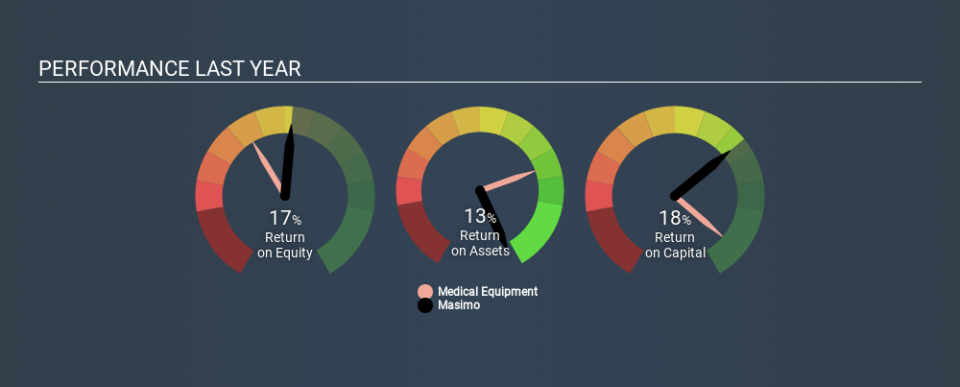Why Masimo Corporation’s (NASDAQ:MASI) Return On Capital Employed Is Impressive

Today we are going to look at Masimo Corporation (NASDAQ:MASI) to see whether it might be an attractive investment prospect. To be precise, we'll consider its Return On Capital Employed (ROCE), as that will inform our view of the quality of the business.
First of all, we'll work out how to calculate ROCE. Second, we'll look at its ROCE compared to similar companies. Finally, we'll look at how its current liabilities affect its ROCE.
Return On Capital Employed (ROCE): What is it?
ROCE is a metric for evaluating how much pre-tax income (in percentage terms) a company earns on the capital invested in its business. Generally speaking a higher ROCE is better. Ultimately, it is a useful but imperfect metric. Author Edwin Whiting says to be careful when comparing the ROCE of different businesses, since 'No two businesses are exactly alike.
So, How Do We Calculate ROCE?
The formula for calculating the return on capital employed is:
Return on Capital Employed = Earnings Before Interest and Tax (EBIT) ÷ (Total Assets - Current Liabilities)
Or for Masimo:
0.18 = US$221m ÷ (US$1.4b - US$172m) (Based on the trailing twelve months to December 2019.)
Therefore, Masimo has an ROCE of 18%.
View our latest analysis for Masimo
Does Masimo Have A Good ROCE?
One way to assess ROCE is to compare similar companies. Using our data, we find that Masimo's ROCE is meaningfully better than the 9.3% average in the Medical Equipment industry. We consider this a positive sign, because it suggests it uses capital more efficiently than similar companies. Regardless of where Masimo sits next to its industry, its ROCE in absolute terms appears satisfactory, and this company could be worth a closer look.
Masimo's current ROCE of 18% is lower than its ROCE in the past, which was 28%, 3 years ago. This makes us wonder if the business is facing new challenges. You can click on the image below to see (in greater detail) how Masimo's past growth compares to other companies.
Remember that this metric is backwards looking - it shows what has happened in the past, and does not accurately predict the future. ROCE can be misleading for companies in cyclical industries, with returns looking impressive during the boom times, but very weak during the busts. ROCE is only a point-in-time measure. Since the future is so important for investors, you should check out our free report on analyst forecasts for Masimo.
Masimo's Current Liabilities And Their Impact On Its ROCE
Current liabilities include invoices, such as supplier payments, short-term debt, or a tax bill, that need to be paid within 12 months. The ROCE equation subtracts current liabilities from capital employed, so a company with a lot of current liabilities appears to have less capital employed, and a higher ROCE than otherwise. To counter this, investors can check if a company has high current liabilities relative to total assets.
Masimo has total assets of US$1.4b and current liabilities of US$172m. As a result, its current liabilities are equal to approximately 12% of its total assets. Current liabilities are minimal, limiting the impact on ROCE.
What We Can Learn From Masimo's ROCE
With that in mind, Masimo's ROCE appears pretty good. Masimo shapes up well under this analysis, but it is far from the only business delivering excellent numbers . You might also want to check this free collection of companies delivering excellent earnings growth.
For those who like to find winning investments this free list of growing companies with recent insider purchasing, could be just the ticket.
If you spot an error that warrants correction, please contact the editor at editorial-team@simplywallst.com. This article by Simply Wall St is general in nature. It does not constitute a recommendation to buy or sell any stock, and does not take account of your objectives, or your financial situation. Simply Wall St has no position in the stocks mentioned.
We aim to bring you long-term focused research analysis driven by fundamental data. Note that our analysis may not factor in the latest price-sensitive company announcements or qualitative material. Thank you for reading.


